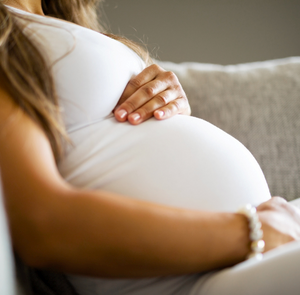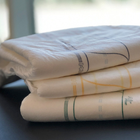An estimated 40% of women experience urinary incontinence during pregnancy. Among pregnant women over the age of 35 and overweight women, that percentage is even higher.
In most cases, full recovery may take up to one year after delivery, although most symptoms are relieved within 6 weeks. Some women struggle longer, some even for the rest of their lives if their symptoms go untreated.
Causes of pregnancy incontinence
During pregnancy, a woman’s body changes a lot. Especially in the first months, the body has to get used to many changes, with nausea, incontinence and several other uncomfortable ailments as a result.
Incontinence during pregnancy is in part caused by changing hormones. In addition, after about three months of pregnancy, the weight of the uterus starts putting pressure on the bladder, causing it to feel full faster and faster.
The pregnancy hormone hCG
The pregnancy hormone Human Chorionic Gonadotropin (hCG) plays an important role in the development of urinary problems during pregnancy.
The hormone causes an increase in the amount of blood in the body, and the supply of blood to the kidneys becomes faster than normal.
This results in the bladder filling up more, and faster, and the pregnant woman will have to go to the toilet more often.
Stress incontinence during pregnancy
While hormonal changes ensure that the muscles in the urethra and pelvic floor are stretched for the delivery of the baby, they also cause weakening of the pelvic floor muscles.
The weakening of the pelvic floor muscles also has an annoying downside. Incontinence and leakage may occur if the pressure on the bladder becomes too great. This can happen, for example, during laughter, coughing or other physical exertions. That is why some women experience stress incontinence during and after pregnancy.
Stress incontinence is more common towards the end of pregnancy, and affects up towards 50-70% of pregnant women.
Urinary Tract Infection (UTI)
A frequent urination pattern and urinary incontinence among pregnant women can often be signs of urinary tract infection (UTI). In any reasonable suspicion, it can only be advised to consult a doctor. During pregnancy, women are more likely to get UTI, because the uterus will place pressure on the bladder and ureters, and, furthermore, it is difficult to completely empty the bladder during pregnancy. This can increase the risk of bacteria, which is followed by an infection (UTI).
Symptoms can differ a lot, as some women experience an uncomfortable feeling of pressure towards the bladder, while others experience a series of Braxton Hicks contractions – also known as false labor. Others again experience pain during urination.
It is important for pregnant women that UTI is treated, because infections can irritate the uterus and provoke contractions leading to labor and premature birth.
Tips for coping with incontinence during pregnancy
Incontinence during pregnancy is very common and generally goes away within 6 weeks after childbirth, once the muscles have had some time to heal. Recovery after pregnancy takes time. The muscle tissue will automatically regain strength within the months following delivery. Most symptoms will gone be within 6 weeks, while full recovery can take up to one year.
Luckily, there are strategies for preventing incontinence and for helping with recovery after childbirth. Remember that it may not be possible to prevent leakage entirely, but these strategies can also help make recovery easier and faster.
Tip 2: Pelvic floor exercises can promote recovery, and can be started before or during pregnancy. By doing exercises daily, the risk of incontinence and the symptoms can be reduced. Pelvic floor exercises post-pregnancy are also relevant for women who had a caesarean section.
A physical therapist can assist in finding the right exercises. A physical therapist can also give personalized advice on finding the correct toilet position, general toilet behavior or eating and drinking habits.
Stress incontinence – or exercise incontinence - is the most common form of incontinence, affecting about 1 out of 5 women over the age of 40.
How to choose the right product
There are many factors to consider when choosing the right incontinence product for your individual needs.





